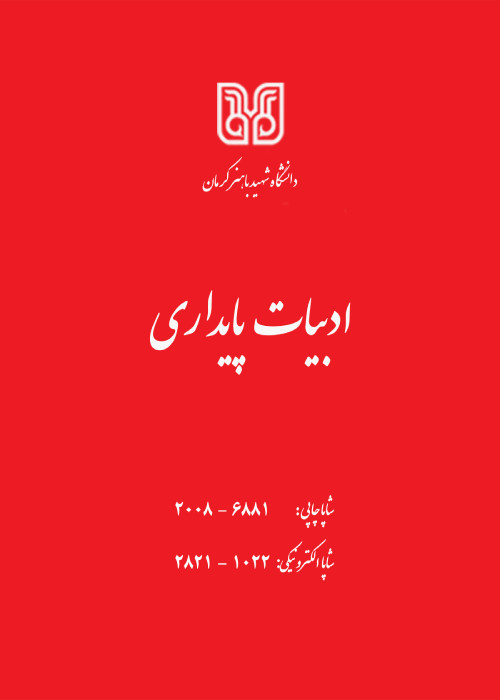The Representation of War to Children in Poetic Illustrations(Case Study: Rhetorical Critique of Imageries in Masoomeh Mehri Ghahfarokhi's Resistance Poems)
War is one of the most violent and harmful phenomena for societies and nations. In addition to the violence and psychological damage of war, the issues of stability and defense of national unity and patriotic values are among the important and obvious issues of war. The transfer of values, stability, resistance of the warriors and the brave men of Iran during the eight-year Iran-Iraq war, provide valuable experiences for children and adolescents. The history of Sacred Defense literature begins and continues from the first days of the war because the events of that time are present today and its memories and effects have remained in the minds, consciences and inside and outside of the generation that has reached the text of the events today. The resistance literature seeks to convey to the audience the human meanings of war or Sacred Defense. But, the main issue in this transition is to determine how the audience relates to these works because children and adolescents are far from the imposed war, at least in terms of time. Resistance literature commits itself to acquainting them with the sacrifices and resistances of warriors and to institutionalizing values, such as endurance, self-sacrifice, empathy, etc. in them. The literary genre of poetry is a good platform for conveying the values and concepts of war and resistance literature. Child and adolescent poets have made many references to war and the issue of resistance in their poems. It seems necessary to provide beautiful and objective images of war events and issues for this age group who do not have a complete experience and understanding of war events.
The research method in this research is descriptive and includes content analysis. The method of collecting information is also in the form of library documents. Masoomeh Mehri's collection of resistance poems has been analyzed and studied in terms of rhetorical functions of the image.
The purpose of this study is to represent the war and its events to adolescents in the poetic illustrations of Masoomeh Mehri’s poems, one of the young poets in the field of resistance. The importance of presenting images related to the war, reflecting the sufferings, courage and perseverance of the brave men of Iran for the generation of children and adolescents and institutionalizing these concepts in the form of appropriate and imaginative images is a significant issue. The use of deep and inner imageries to connect the audience with the poems and internalize the concepts of war has required the poet to present and use effective images. Poetic images have been criticized based on the principles of rhetoric and imagery levels (introversion or extroversion of images, depth or superficiality of images).The research questions are: 1. what kind of images has the poet used to acquaint the adolescent audience with the concepts of war? 2. In addition to conveying the concepts of sustainability, have the poetic images been able to present an attractive and different image of war (reducing the burden of war violence) to the audience? And what is the function of each type of image in the poet's poetry?In the category of extraversion and introversion of images, the issues of superficial and deep images are studied and analyzed. The importance and application of this type of images in attracting the audience and institutionalizing the concepts of resistance and war for the audience including children and adolescents. In her collection of poems, the poet has paid attention to both types of images (deep and superficial). The poet's ability to use superficial and deep images appropriate to the situation of the child's audience is remarkable and thought-provoking. As the age of the audience increases, the poet increases the depth of the images. This can be seen in the book My Mother Iran Banoo. To be more effective, the poet deepens her poetry in terms of images and emotion. Another type of rhetorical images is the random image. Images that are formed through a deep and imaginative connection between phenomena in an abstract course and are exciting for the audience.
The results of the research showed that Masoomeh Mehri has used pristine and fresh images to represent and reconstruct the war and its events. All kinds of images of surface and depth, incidental and positive can be seen in her poetry. He has used positive images to express his national belief and patriotism, images that have both an element of imagination and emotion within them. It uses superficial images to describe the ugliness and cruelty and violence of war. Images whose emotional load reduces the violence and horror of war. In the collection My Mother Iran Banoo, Mehri depicts the beginning, the peak and the end of the war in 15 beautiful literary paintings. The poet's avoidance of stereotyped and repetitive images is the most important feature of this collection. The deeper we move the images from the beginning of the boards to the middle and the end. To the extent that it leads to the creation of amazing and random images. The sum of random and deep images has been used more than positive and superficial images. The reason for this is the poet's attempt to provide deep images of the war and to avoid repetitive and clichéd images. Using myths, historical sites (Alamut Castle), historical events (Mongol and Alexander invasions of Iran, burning of Persepolis) and referring to these events in the background, in addition to deepening the image, the poet provides the presence and participation of the audience in the poems.
- حق عضویت دریافتی صرف حمایت از نشریات عضو و نگهداری، تکمیل و توسعه مگیران میشود.
- پرداخت حق اشتراک و دانلود مقالات اجازه بازنشر آن در سایر رسانههای چاپی و دیجیتال را به کاربر نمیدهد.



